This Notebook collects references to, and sometimes reprints of, primarily technical texts and images of the cutting of typographical punches in steel by hand. For a set of links to locations in CircuitousRoot which discuss various aspects (technical and nontechnical) of punchcutting in steel by hand, see ../../ Hand Punchcutting in Steel. For practical studies (at such time as I get to them) see the book ../../ Making Matrices , and within it especially the Punchcutting by Hand in Steel section. Punchcutting assumes that matrices will be struck/driven from the punches and then justified. For this see ../../ Making Matrices -> Striking/Driving and Justifying Matrices by Hand.
For the literature on punchcutting by (pantographic) machine, see ../ Machine Engraving.
There is considerable overlap between punchcutting and patrix cutting. For a set of links to locations in CircuitousRoot which discuss patrix cutting, see ../../ Patrix Cutting in Soft Metal (By Hand and Machine).
There have been a number of more-or-less well-known illustrations which have been said to show (or which have been misinterpreted later as showing) punchcutters and/or their tools but which in fact show patrix cutting in soft metal (and its tools). So, for example, Alexander Lawson, in Anatomy of a Typeface {Lawson 1990}, uses Mahr's 1928 illustration of a patrix cutter (fourth photograph below) to show a "Punchcutter at the Bauer Foundry" (p. 393) 1 I've made this mistake myself as I came better to understand these processes. These illustrations are now treated in the Notebook of literature on ../ Patrix Cutting in Soft Metal.
In particular, each of the photographs or illustrations below (in thumbnail form, just for identification) are of patrix cutters, not punch cutters. See the Patrix Cutting in Soft Metal Notebook.
It is easy to find pictures of typographical punches online and in books. It is more difficult to find detailed technical information on their making. This Notebook attempts to collect everything I know of, either as a bibliographic reference or (when possible) directly reprinted.
The order here is chronological (with some exceptions). Major and minor texts are mixed together. Since it's impossible for a beginner to know beforehand which texts are the most important, here's a short list of the essential works in English (or for which there have been translations into English):
In the future, it is clear that the primary text will be Stan Nelson's forthcoming work on typographical punchcutting.
I first expected this bibliography to be quite short, since there are so few comprehensive texts. I've found instead that the deeper I look, the more I find. Thus it has become quite long - and possibly therefore confusing. But this is a good thing (not the confusion, of course, but the fact that so much material exists). If you're just starting out, stick to the sources above. I'd start with Paul Koch's "The Making of Printing Types" (1933) and go on to Stan Nelson's films ( Nelson. From Punch to Printing Type (1985) and Nelson. Punchcutting at the Atelier Press & Letterfoundry (2009) ). From there it's up to you.
My thanks to Stan Nelson for pointing me at several sources in this list. I'm sure I've missed many others.
Several of these entries will seem buried in bibliographic detail. That's because the publication history of most of these sources has been unnecessarily complicated: full of partial reprints, inexact citations, the difficulty of the book trade over the centuries, and general obscurity. The entries here are an attempt to sort out what was what and to identify where it may be found. If this makes this bibliography more difficult, then I apologize for that. But for myself, at least, I need to track things down to this level of detail.
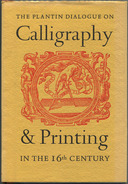
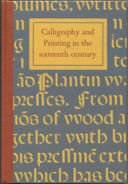
Plantin (1567)
No text before Moxon will give the apprentice punchcutter much assistance in the workshop. Still, the few early texts should be noted if only because they are so few and so late.
The first technical description of punchcutting and typefounding occurs in what is in principle a book of instruction for children (or more likely parents wishing to learn things to teach their children) published in 1567 by Christophe Plantin (and possibly written by him): [La premiere, et la seconde partie des] Dialogues Francois, pour les ievnes enfans (Antwerp: Plantin, 1567). It is very brief; my bibliographic account of it here is much longer than the text itself.
It is worth pausing, first, to consider the date of this book: 1567. If one places the origin of printing in round numbers at 1450, this means that the first book to describe the technology of printing types did not appear until 117 years after that technology was introduced. To put this in contemporary perspective, imagine that the Wright Brothers first flew in 1903 (as they did) and that aviation then became commonplace throughout the known world (as it has, of course - just as printing was by Plantin's time). But by the same timescale, as I write this in 2016 it is as if the first magazine article describing how an airplane works still won't be written for another four years, and the first technical book on aircraft engineering won't be published until the middle of the 22nd century. It is too easy to compress the past. A century is five generations; it has always been a long time, even in the 1500s.
Plantin's text takes the form of a didactic dialogue, with parallel texts in French and Flemish. Only one copy survives, in the Plantin-Moretus Museum in Antwerp. To the best of my knowledge, it has been reprinted in its entirety only once, in commemoration of the 350th anniversary of the death of Christophe Plantin: La première, et la seconde partie des dialogues François, pour les jeunes enfans (Antwerp: Plantin, 1939). 2
A photographic copy of this original is online via Anet.be, the "network of twenty academic libraries in the region of Antwerp and Limburg" ["het netwerk van een twintigtal wetenschappelijke bibliotheken in de regio Antwerpen en Limburg."] Its terms of use prohibit its reproduction here, but it may be viewed online and/or downloaded for personal scholarship at: http://anet.uantwerpen.be/digital/opacmpm/mpm/dg:mpm:895/N Its catalog entry is at: http://anet.be/record/opacmpm/c:lvd:1115085/N The passage on punchcutting and matrix making begins on p. 236 of the original, which is image 121 of this PDF.
As a typefounder, I find it interesting that the two weights used to hold the book open for photography at the Plantin-Moretus are Elrod-cast leads. Only the Elrod (or the few late machines copying it) could produce solid material with through-holes in in this manner.
In 1940, Ray Nash translated the portions of this book concerning writing and printing. This was published together with a facsimile of the original pages in French and Flemish:
Nash, Ray, ed. Account of Calligraphy and Printing in the Sixteenth Century. Cambridge, MA: Dept. of Printing and Graphic Arts of the Harvard College Library, 1940.
Worldcat indicates that the design of this book was by Bruce Rogers. Worldcat also cites Christophe Plantin and Jacques Grévin as authors, but these are (sound) presumtions argued for by Nash; the original text is anonymous. The 1964 edition's dustjacket says that it (the 1940 edition) was printed by D. B. Updike's Merrymount Press (this would have been a year before Updike's death) and that only 250 copies were printed. I have not yet seen it.
I cannot resist an aside on this book as a delight of scholarship. It contains Plantin's text in facsimile, of course (itself in two languages). But Nash doesn't simply present his translation of this text. The translation runs on the right-hand page (mostly, except when some illustrations spill over onto it), while on the left he presents a running bibliographic commentary which both explores and illustrates Plantin's dialog. For the section on writing ("calligraphy"), in particular, he illustrates the various "letters" (hands) mentioned by "H." (probably Pierre Hamon) with samples from Hamon's book Alphabet de l'invention des lettres en diverses escritures (1561), the earliest surviving printed book on writing. At every turn, Nash's commentary provides something new - or, rather, something old - to illuminate Plantin's rather plain dialogue. His book is perfect in every respect; a marvel of letters, bibliography, and printing technology.
In 1964, an enlarged section edition of this work appeared:
Nash, Ray, ed. Foreword by Stanley Morison. Calligraphy and Printing in the Sixteenth Century. Antwerp, Belgium: The Plantin-Moretus Museum, 1964.
Although technically published in Antwerp, it was printed by The Stinehour Press in Lunenberg, Vermont, with photo-litho-offset illustrations by The Meriden Gravure Co. - these are major names in fine printing in America in the 20th century - and the facsimile of the original done in collotype by L. van Leer & Co. (in Amsterdam). Modest in size, it is a splendid physical book done at the high-water mark of Twentieth-Century printing.
This book may present some confusion to the bookseller, since the title on the dustjacket prepends "The Plantin Dialogue on" to the actual book title. The two thumbnail images above present first the dustjacket and then the cover (on which the title is identical to the form used on the title page).
Harry Carter, in A View of Early Typography Up To About 1600 {Carter 1969} prints Plantin's brief dialog in his own English translation. He says of it "I like Plantin's introduction to typefounding: it makes it sound so easy."
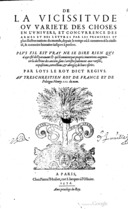
Le Roy (1575)
The next (semi)technical reference to punchcutting (of which I am aware) occurs as a short passage within a much longer work by the French humanist Loys Le Roy (Louis Le Roy, Ludovicus Regius), De la vicissitude ou variete des choses en l'univers, [etc.] (Paris: Pierre l'Huilier, 1575). This book went through several editions. Gallica, the digital library of the Bibliothèque Nationale de France, has the 1575 edition online at: http://gallica.bnf.fr/ark:/12148/bpt6k108667z/ It has also been scanned by Google at least four times. The icon at left links to a local PDF of the Google scan of the Austrian National Library copy (Google Books ID: 0TtOAAAAcAAJ).
The value of passages such as this one is not so much for practical workshop instruction as for understanding the history of the technology. By noting that the practices described do not differ from later and more completely understood practices, we can push the limits of our documented knowledge that much earlier.
The passage in question occurs on the page between 19 and 20 as a part of the discussion of the variety of languages:
The entirety of Le Roy's book has been translated into English only once, just a few decades after it was published:
Ashley, Robert. Of the interchangeable course, or variety of things in the whole world [etc.] London: Printed by Charles Yetsweirt Esq. at his house in Fleetestreete neere the Middle Temple gate, 1594.
This 1594 translation has been scanned by Google from an unspecified library, but in their wisdom they have declined to permit it to be viewed. It is online via the Text Creation Partnership / Early English Books Online in at least transcribed format (I don't have proper institutional access, and so don't know if page images exist online) at: http://quod.lib.umich.edu/e/eebo/A05335.0001.001/1:2?rgn=div1;view=toc. The text of this passage, in Ashley's translation, reads:
TO MAKE Characters for imprinting, it is requisite first to haue ponchions of steel, softned by the fire, on the which they graue with coūter-ponchions hardned, or grauing yrons steeled, the white which is within the letters: perfecting and smoothing the bodies of them with fyles, where they are eminent, or vneuen; not at the right ends, but at the contrarie: after they wet these ponchions in water to harden them, and then polish them, and do strike them into little peeces of fine copper, that haue bin in the fire: which being so engrauen, do naturally represent the forme of the letters: which the artisans do call, striking of the matrices: Then do they iustify their matrices on moulds of yron, and in the white therof make their castings, with lead, tinglasse, antimony, and other mixed maters; to the end to harden them: and that they may endure the longer. The Letters being thus cast & made, are put in a great case or box of wood, ful of little boxes, in to which they are distributed, according to their seuerall sorts.
This passage (which continues to describe other aspects of printing) was also the subject of a book by Herbert Davis, Loys Le Roy on the Art of Printing (Oxford: Bibliography Room of the New Bodleian Library, 1955). This is quite a scarce volume; I haven't seen it yet.
Ray Nash, in his 1964 edition of Plantin's ievnes enfans (see above) translates this passage into 20th century English (p. 44). 3

Moxon. Mechanick Exercises (1683)
Joseph Moxon's Mechanick Exercises, Or, the Doctrine of Handy-Works Applied to the Art of Printing covers all aspects of type-making and printing. It was the first general work on this subject in English, and although not without issues, it remains one of the best sources for pre-industrial type and printing technologies.
The icon here is of the cover of the Dover reprint {Moxon 1978} of the 1962 second edition of the edition of Moxon edited by Herbert Davis and Harry Carter {Moxon 1958/1962}. They published their edition under the title: Mechanick Exercises on the Whole Art of Printing. You can't click on this icon; you have to go out and buy a paper copy of this book. It is, of course, out of print. But the person who does not have some version of the Davis & Carter edition of Moxon in their library is no typographer.
The Bibliography of Mechanick Exercises : The publishing history of the two volumes of Moxon's Mechanick Exercises (the second on printing (including type-making) and the first on various mechanical arts) is extremely complex. Moreover, the aspiring punchcutter should be familiar with both volumes (or at least the second and the section on Smithing from the first). For a bibliographic discussion of these works, see the Notebook on Moxon's Mechanick Exercises (which happens to be in a portion of the section on Moxon devoted to complex or "Ornamental" turning).
Moxon's original text is now a scarce antiquarian item. This volume of "Mechanick Exercises" on printing has never been reprinted in freely available facsimile. It was, however, reprinted in a re-set version attempting some degree of typographic similarity by the great American printer Theodore Low DeVinne {Moxon 1896}. Links to, and local copies of, these digitizations are available on the CircuitousRoot Notebook of "General Literature on Making Printing Matrices and Types. Here is a local copy in PDF format of the chapter on "Letter-Cutting" extracted from the Google Books digitization of the University of Virginia's copy of the 1896 DeVinne reprint of Moxon: moxon-devinne-1896-google-virginia--mechanick-exercises-EXTRACT-letter-cutting.pdf
(There was also a condensed extract including some material on punchcutting published in the Universal Magazine in 1750 ; this was reprinted by Fred Anthoensen in 1939. A partial reprint in facsimile, including material on punchcutting but not typefounding, was published as a supplement to The Caxton Magazine in 1901 .)
Confusingly, Moxon wrote two major works which bore the same title: "Mechanick Exercises." 4 Now we think of them as separate books, but Moxon thought of them as one large work (he refers in the second to articles in the first as if it is just an earlier volume of the same work). Each of these Mechanick Exercises has had a complex publication history.
In antiquarian machinist's circles, he is better known the first volume of his Mechanick Exercises, first published serially from 1678 to 1680 and devoted to Smithing, Joinery, Carpentry, and Turning" (his son James Moxon later added a section on Bricklayers-Work). This first volume of Mechanick Exercises has been reprinted variously (e.g., {Moxon 1994}). For further information, see the Notebook on Moxon in the CircuitousRoot Notebooks on Ornamental Turning and Related Work.
In printing circles he is better known for the second volume of his Mechanick Exercises, "Or, the Doctrine of Handy-works Applied to the Art of Printing." This was published serially in 1683-1684, and is the volume referenced here. These two volumes were published together only once, upon the completion of the second in 1684 ( {Moxon 1994}).
Yet the punchcutter desiring to follow Moxon will have need of both volumes. Moxon says that "the making of Steel Punches is a Branch of the Smith's Trade," and several times refers to the section on Smithing in his first volume.
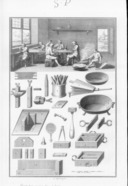
Académie Royale / Jaugeon (1690s - 1704)
In the 1690s a group reporting to the Académie Royale des Sciences (Paris) began an exceedingly ambitious project to produce a comprehensive description of crafts and industries. This project ultimately was not realized in its full scope. In particular, the plates illustrating punchcutting and typefounding were not published until the late 20th century (by James Mosley, in Matrix No. 11), and the 1704 text by Jaugeon which they accompanied has still not seen publication in print.
A transcription and translation of the section of Jaugeon's text (and plates) on the hand mold was published by James Mosley in 2015. A low-resolution digitization of an 18th century copy of the entire manuscript, with plates, is now freely available via the "Gallica" digital library of the Bibliothèque nationale de France. Despite its resolution issues, this digital edition, the first full publication of this work in the three centuries since it was written, is one of the most important documents in the history of typefounding today.
Understanding this work and its publication history requires a fair bit of background information. It's best to do this in one place only. The icon above left links to a Notebook in the General Literature on Making Printing Matrices and Types which discusses its history, links to its publication at Gallica, and extracts and reprints its plates.
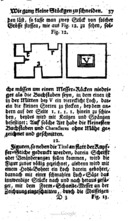
Kurtze ... von Stahlschneiden (1740)
Anon. [possibly Johann Michael Funcke]. Kurtze, doch nützliche Anleitung von Form- und Stahl-Schneiden. [Short, but Useful Guide to Wood and Steel (punch) Cutting.] [City of] Erfurt, [Electorate of Mainz, Holy Roman Empire]: Johann Michael Funcke, 1740. { Kurtze... 1740}
This work has not yet been translated from its original German (but see the copy digitized from the National Library of the Netherlands, reproduced below, for a contemporary French translation). It has been reprinted in a modern two-language edition (bilingual Introduction in German and English, with a facsimile of the original work):
Boghardt, Martin, Frans A. Janssen and Walter Wilkes, eds. Intro. by James Mosley. Kurtze Anleitung von Form- und Stahlscheiden. Darmstadt, Germany: [no publisher identified], 1998. { Kurtze... 1998}
This edition is worth having even for those who, like myself, cannot read German, simply because of its English-language Introduction by James Mosley. In it, Mosley says of the section on punchcutting in this work that it "is a valuable supplement to the earlier work of Joseph Moxon in England and the later manual of Fournier, and it has a special interest since it is specifically concerned with the making of Fraktur characters" (pp. 59-60 of the 1998 Darmstadt edition) Mosley's Introduction is also particularly valuable because of its discussion of alternative methods of matrix making which have generally been ignored in modern histories of type.
The original German text of 1740 has been digitized at least three times by Google, from copies at the University of Lausanne, the National Library of the Czech Republic, and the National Library of the Netherlands. This last copy seems to be the one that Mosley identifies from The Royal Library at The Hague (p. 55), which has a manuscript translation into French interleaved with the printed German text. Here are local copies of all three:
It appears that a non-Google digitization at the Sächsische Landesbibliothek - Staats- und Universitätsbibliothek in Germany is in process at this time (2016).
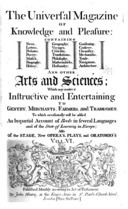
[Moxon, Extract] Universal Magazine (1750)
Moxon, Joseph [communicated by "A.B."] "The Art of Cutting, Casting, and Preparing of Letter for Printing, with a neat Representation of a Letter-founder's Work-house." The Universal Magazine. Vol. 6, No. 6 (June 1750): 274-278.
This is a condensed extract from the second volume of Moxon's Mechanick Exercises. See the entry on Moxon, above.
The icon here links to the presentation of this work in the Notebook of General Literature on Making Printing Matrices and Types.
This extract was reprinted in 1939 by Fred Anthoensen.
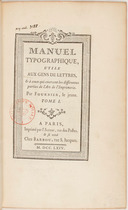
Fournier (1764)
The first volume of the Manuel Typographique (1764) by Pierre-Simon Fournier remains the single most important text on typographical punchcutting. Unfortunately, although an excellent translation into English was done by Harry Carter in 1930, access to this translation remains difficult. The icon at left links to the discussion of the bibliography and (limited) online sources for this work in the CircuitousRoot Notebook of "General Literature on Making Printing Matrices and Types.

Diderot (1752 & 1763)
The Encyclopédie of Denis Diderot and Jean le Rond d'Alembert contains some information on, and some illustrations of, typographical punchcutting. Finding this information is difficult, however, since the discussion appears in the article "Poinçons a lettre, gravure des, pour les caracteres d'Imprimerie." Vol. 12, p. 867." which refers to plates which should be under "Gravure," but in fact the plates appear in the section of plates entitled "Fonderie en caracteres d'imprimerie, précédée de la gravure des poinçons, Les deux Arts contenant huit Planches" in Volume 2, Part 1 of the plates volumes. See the CircuitousRoot Notebook on Diderot & d'Alambert on Typefounding within the CircuitousRoot Notebook of "General Literature on Making Printing Matrices and Types for a discussion of (and reprints of) this material. To the best of my knowledge, it has not been translated into English.
The icon here links directly to a PDF extract of the materials on typefounding, from the materials of the ARTFL Encyclopédie Project of the University of Chicago.
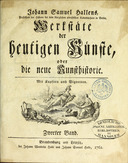
Hallens [Halle], Werkstäte der Heutigen Kunste (1762)
The Werkstäte der Heutigen Kunste, oder die Neue Kunsthistorie ("Workshops of the contemporary arts, or the new art history") of Johann Samuel Hallens (or Halle) of 1762 is a survey intended for a general audience. Volume two of this six-volume work contains a section on punchcutting and typefounding. The icon at left links to the main entry for this book in the Notebook of General Literature on Making Printing Matrices and Types (which contains reprints, information on Dan Reynolds' translation of it, and the plates).
Hallens was not himself a trained punchcutter or typefounder. Its section on punchcutting and typefounding derives primarily from two earlier works, Geßner's Die so nöthig als nützliche Buchdruckerkunst und Schriftgiessereÿ mit ihren Schriften (1740) and the anonymous Kurtze, doch nützliche Anleitung von Form- und Stahl-Schneiden [Short, but Useful Guide to Wood and Steel (punch) Cutting] sometimes attributed to Johann Michael Funcke. (For more on the first of these, see the entry on Geßner in the Notebook of General Literature on Making Printing Matrices and Types . For more on the second, see the entry on it above .
Dan Reynolds' translation of Hallens is of particular value because it gives us access, in English, to some of the information in Geßner and Funcke and, through that, to German practices in punchcutting at the time. Some of these, such as the use of vinegar to matte the polished finish of a punch's face prior to transferring the image to it, are procedures that I do not recall having seen elsewhere. His translation (with an introduction in English and also a reprinted text in German, but without the plates) was published under the title "An Essay on Typefounding" in the occasional journal and typographical specimen book Cast it, #3 (Milan, Italy: Lazy Dog Press srl, 2019). ISBN: 978-88-98030-27-9. ISSN: 2531-765.
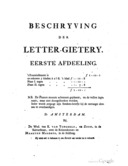
Fleischman (ca. 1766/1768)
A few technical resources are associated with the punchcutter Johann Michael Fleischman (born 1701 in the Free and Imperial City of Nuremberg in the Holy Roman Empire, worked primarily in Amsterdam in the Republic of the Seven United Netherlands, died 1768 - politically, Europe in the 18th century was not the same as it is today).
The item of most immediate interest is a portrait done near his death which shows him holding a hand mold and surrounded by tools of the punchcutter:
(Here is the same image wrapped in PDF format, which may scale better for you:
enschede-1768-google-fr-gand-Epreuve_de_caractères_qui_se_fondent_da-o709AAAAcAAJ-ghent-but-missing-cover-extract-pdf27-fleischman-portrait-2264x1940-rewatermarked-png.pdf.
This portrait has been reproduced many times. The version above is from the 1768 Proef van Letteren of the Enschedé type foundry as digitized by Google France from the University of Ghent copy, Google ID: o709AAAAcAAJ ). See the Notebook on The Typefounder's Hand Mold: Literature for further information and different digitizations. Curiously, even though this specimen book bears the date 1768, the portrait signed 1769.
The other item is more complicated, and less useful to the beginner. As reconstructed by Frans A. Janssen, in the 1760s the type foundry of the brothers Ploos van Amstel in Amsterdam conceived of a project to create a comprehensive description of type making. Only the first part of this was published, as Beschryving der Letter-gietery (Amsterdam: The Widow of K. van Tongerlo and Son and Maarten Magerus, 1768). It treats primarily of type-metal, and only very briefly of matrices and punches. The icon above Fleischman's portrait, above, links to a local PDF of the Google scan of this work from the National Library of the Netherlands copy; or click here. It isn't clear to me that this copy is complete, but I can't read Dutch.
A very rough draft of the next portion, on punchcutting, has survived as an anonymous manuscript now attributed to Fleischman. The history, and at least a partial transcription and translation, of this manuscript can be charted through a series of scholarly and fine press publications by Frans A. Janssen:
{Janssen 1988} [an article by Janssen in] Het oude en het nieuwe boek, de outde en de nieuwe bibliotheek [I think that this must be a festschrift for H.D.L.Vervliet] Kapellen, Belgium: DNB/Pelckmans, 1988.
I haven't actually seen this, and couldn't read it if I did. Janssen cites it in his 1990 Quaerendo article as his original publication.
{Janssen 1990} Janssen, Frans A. "Ploos van Amstel's description of type founding." Quaerendo, Vol. 20, No. 2 (1990): 96-109
This is Janssen's basic article in English on the 1766 manuscript. It contains transcriptions from it, with translations of them into English. It isn't entirely clear to me that the transcriptions are complete; they might be, but this is a scholarly article about the manuscript's history, not an edition of it. At the time this article was written, Janssen had not yet conclusively attributed this manuscript to Fleischman. You can buy this article in digital form from the publishers, Brill.
If you're becoming obsessive about punchcutting, then, yes, you should have it. If you just want to cut a punch, you don't need it.
{Janssen 1994A} Janssen, Frans A. "Ploos van Amstel's Manual and Fleischman: An Addendum. Quaerendo, Vol. 24, No. 2 (1994): 136-137.
In this two-page addendum to his earlier article, Janssen concludes that this anonymous manuscript may be attributed to Fleischman (and in fact is in his hand). You can buy this very brief article in digital form from the publishers, Brill, for the same price as the much longer 1990 article.
{Janssen 1994B} Janssen, Frans A., ed. Fleischman on Punchcutting. Aartswoud, Netherlands: Spectatorpers [the Press of Bram de Does], 1994.
This is a fine press volume based on Janssen's articles. I haven't seen it, and don't know to what degree it differs from them. It was mentioned in an article by Sebastian Carter on Bram de Does published in Parenthesis (Fine Press Book Association) which is online at: http://www.fpba.com/parenthesis/select-articles/p14_the_spectatorpers_the_press_of_bram_de_does.html . Flickr user "Davo Typo" took a photograph of its frontispiece and title page in 2007: https://www.flickr.com/photos/15230880@N02/2082514727
On spelling: Frans A. Janssen writes "Johann Michael Fleischman." Enschedé has "Joan Michael Fleischman" in both the portrait shown above (taken in this instance from one of their specimens) and in (for exmaple) De Lettergieterij van Joh. Enschedé en Zonen: Gedenkschrift ter gelegenheid van haar honderdvigftig-jarig bestaan (Haarlem, Netherlands: Joh. Enschedé en Zonen, 1893): 4. For reasons not yet clear to me, Wikipedia has "Joan Michaël Fleischman."
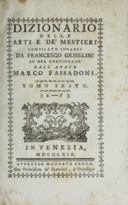
Fassadoni. Dizionario... (1769)
Griselini, Francesco (original editor) and Marco Fassadoni (editor of this volume). Dizionario delle Arti de' Mestieri. Vol. 6 ("E-F") Venice, Republic of Venice: Modesto Fenzo, 1769.
This is the earliest description of punchcutting and typefounding in Italian. The icon at left links up and over to a more complete entry on Fassadoni in the Notebook of General Literature on Making Printing Matrices and Types .
Excerpts from the sections on punchcutting and typefounding were reprinted in Italian, but with a forward in English by James Clough, in the occasional journal Cast it, #1 (Milan, Italy: Lazy Dog Press srl, 2016). This reprint does not include the six plates of the original.
Here is a Fassadoni's Plate VI, showing punchcutter's tools, from the Getty Research Institute digitization of this work as hosted at The Internet Archive (see the link above for more information on this).

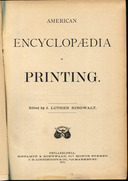
Ringwalt (1871)
Ringwalt, J. Luther, ed. American Encyclopædia of Printing. Philadelphia: Menamin & Ringwalt, 1871.
The cover and titlepage illustrations in the icons at left are scans from my own copy. They link, however, to a local PDF copy of the Google digitization of the Harvard University copy (Google ID: ztQoAAAAYAAJ).
This work contains a plate which shows the operations of a type foundry in a composite view. One of the views is of "Punch-Cutting." Very little detail is discernable, but it is significant insofar as it shows a punchcutter at work in a standing position. This necessitates an unusually high bench pin. I know of no other instance of this.
(It is very difficult to tell whether this shows a punch or a patrix cutter. I would argue that it does show punch cutting based on the position of the man's left hand, which seems to be in a better position for grasping the shank of a punch than a typical patrix blank.)
See the entry on Ringwalt in the Notebook of General Literature on Making Printing Matrices and Types for a full presentation of the plate from which this image is extracted.

American Bookmaker (1889)
Anon. "Punch Cutting." The American Printer and Lithographer. Vol. 8, No. 1 (January 1889), p. 18. The icon at left links to an extract of this article from the Google Books scan (ID: T4DnAAAAMAAJ) of the University of Michigan copy.
This is a brief and superficial article which is probably derived primarily from Foucher and which speaks more to design than making. It appeared in the occasional "Graver & Matrix" column of the journal The American Bookmaker (which later became The American Printer and Lithographer and which ultimately merged with The Inland Printer

Foucher 1905 Catalogue
Matériel d'Imprimerie / Catalogue Général. Paris: Société des Etablissments A. Foucher, 1906. (The icon at left is a link to the presentation of this Catalog in the Notebook on the Foucher firm.
The French firm of Foucher introduced the most successful style of "automatic" typecasting machine in 1878 (that is, a type casting machine which delivered fully finished types ready for fonting). They also manufactured and sold a full range of equipment for the typefounder and the printer. Their 1905 General Catalogue contains punchcutting tools. (See p. 37 of the Catalog, "Outillage pour la Justification des matrices et la Gravure des Poinçons.")

Williams Engineering 1919 Catalogue
Some of the typefoundering tools shown in the Williams Engineering catalog of "Type Founders' Equipment" (circa 1919) are used in matrix justification and therefore are of interest to the punchcutter. The icon at left links to a presentation of that catalogue in the Typefounders' Equipment Suppliers' Literature Notebook.
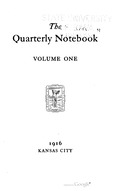
Dard Hunter (1916)
Hunter, Dard [Sr.] "Seventeenth-Century Type-Making," The Quarterly Notebook, Vol. 1, No. 3 (October 1916): 49-54. (Kansas City [no state given, probably MO]: [no publisher], 1916.)
Although he was better known for his work in papermaking, and although he always stood slightly apart from the rest of the typographical world, Dard Hunter did cut punches in steel by hand for his own types (1912-1914). The article linked here is a brief popular account, not overly detailed, of punchcutting in steel and hand casting generally after Moxon's methods.
The icon here links up-and-over to the presentation of this text in the Notebook on Dard Hunter Sr.
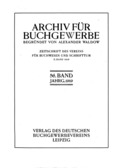
Rudolf Koch (1919)
Koch, Rudolf. "Über die Kunst des Stempelschnitts." Archiv für Buchgewerbe. Vol. 56, No 11/12 (1919): 179-181.
This volume has been digitized by Google from the Princeton University copy and is available via The Hathi Trust (Hathi ID: njp.32101074868561). The icon at left links to an extract of Koch's article.
A translation of this article, with some omissions, by H. J. von Schmöger appears in Gerald Cinamon's biography Rudolf Koch: Letterer, Type Designer, Teacher. {Cinamon 2000}: 62-63.
This article was written several years before Koch attempted to cut his first types himself. See also his 1932 article "Vom Stempelschneiden" and of course the very important 1933 article by his son Paul Koch, "The Making of Printing Types."
As you read the following sections, it may seem as if I'm spending too much time on the details of the publications - and illustrations - of Rudolf Koch and his circle (Paul Koch, Fritz Kredel, Victor Hammer, Warren Chappell, et al.) It certainly feels that way to me as I write this midway through the process! It is worthwhile, though, to understand in some detail the exact methods and tools that Koch and his circle employed so that they may be placed within the larger history of typographical punchcutting.
The work of Koch and his circle was always respected, but the influence of the types that they cut by hand on the history of type was slight. Koch's Neuland has achieved some notoriety as a display face, but his love of blackletter has distanced him from the mainstream. Similarly, Hammer's uncials stand apart. (This might also be said of the types of Dard Hunter Sr. and Jr., which were made in the same William Morris inspired tradition as those of Koch and his associates.)
But the influence of this group on our present understanding - or rather misunderstanding - in America of the history of type-making has been overwhelming. They wrote so well - Paul Koch and Warren Chappell especially - that they have written for us the story of "how type was made" before machine methods. But they were looking backward, in the tradition of William Morris, to re-create an earlier method of type-making. They weren't a part of the survival of hand methods in type-making in the 20th century (as represented by several of the punchcutters discussed by Lane). In documenting their own methods so well, they were not documenting the methods of hand type-making since the major changes which overtook it in the middle of the 19th century. In particular, their success in print helped to erase from American typographical history the hand patrix cutting which dominated mid-19th century display type and was still important through the middle of the 20th century. Yet it was not their intent to skew history. Paul Koch, at least, was very clear that he was describing nothing more than the very personal way he made type. If we read into their work more than what they said, the fault is ours.
(Aside: I used the showing of Neuland from the 1928 Continental Typefounders' Association Specimen Book of Continental Types to represent Rudolf Koch because after a fairly thorough search I was unable to discover a public domain portrait of him.)

Rudolf Koch, Silhouette (1930)
In 1930, the members of Rudolf Koch's "Offenbacher Werkstatt" created a birthday card for their supporter, Prof. George Haupt. It consisted of 13 panes of images (plus two of lettering) illustrating their various crafts in silhouette. Koch presented himself as Der Stempelschneider.
Gerald Cinamon, in his biography of Koch, reproduces this card via a photograph (taken at an angle) from its presentation at the Klingspor Museum {Cinamon 2000}: 145.
In itself this isn't a particularly useful technical document, but it does prefigure Koch's drawings for his 1932 article in The Colophon . By itself the profile of a punch in a bench vise is confusing, but in light of the later Colophon article it is clear that it is being held for counterpunching. That, in turn, raises the technical question of how to hold a punch for counterpunching. Here's a preview of the similar figure in the Colophon article:

Rudolf Koch, "Vom Stempelschneiden" (1931)
Koch, Rudolf. "Vom Stempelschneiden." Gutenberg-Jahrbuch (1931): 290-292. Reprinted in the Klingspor type foundry's specimen booklet for Jessen-Schrift.
The 1931 German version of "Vom Stempelschneiden" in the Gutenberg-Jahrbuch is illustrated with a single cut showing five states of punchcutting, with German captions (as shown in the icon above left which represents this text).
Rudolf Koch was an artist, letterer, and letterform designer who created the letterforms for a number of types realized by the Klingspor foundry. He cut three of his own with his own hands (Neuland (1923), Jessen-Schrift (1926), and Marathon (1930)) and supervised the cutting of his face Claudius by his son Paul Koch.
Nevertheless, it is important to realize that although Koch was employed by a type foundry and although he cut types for faces issued by that foundry, he stood apart from - and to some degree in opposition to - the matrix production department of that foundry. (He objected in particular to their use of the graver and the practice of working from transferred drawings.) He was not a professionally trained punchcutter working within the inherited traditions of this field. He certainly had access to the matrix department at Klingspor, but he was a self-taught punchcutter. His was deliberately reinventing earlier techniques of hand craftsmanship and rejecting machine methods in the romantic tradition of William Morris (though he saw himself doing this for moral and religious reasons). Fournier tells us of the professional practices of punchcutting in his day. Rudolf Koch tells us of old methods rediscovered. It is especially important to situate Rudolf Koch in the history of type-making, because the article by his son Paul Koch in The Dolphin has become perhaps the single most influential technical text on type-making since Fournier. (To this may be added Warren Chappell's chapter on punchcutting in his 1970 book A Short History of the Printed Word. )

Rudolf Koch & Fritz Kredel (1932)
Koch, Rudolf and Fritz Kredel, with Warren Chappell. "On Punch Cutting & Wood Cutting." The Colophon [original series], Part Ten (1932): [unpaginated].
This article is also reprinted inline in Gerald Cinamon's biography of Koch {Cinamon 2000}: 144-147. Cinamon makes some changes, however. For example, in the fourth sentence Koch (or Chappell) writes "The resulting conus..." while Cinamon has "The resulting body..."
This article and the issue of The Colophon in which it appeared are in the public domain. The icon above left links to a reduced-size (300 dpi) scan of this article from my copy (54 Megabytes). Here is a full-resolution (600 dpi, 174 Megabyte) version: colophon-ser1-no10-1932-koch-kredel-punchcutting-woodcutting-0600rgbjpg.pdf
This article is illustrated by four woodcuts. The second of these, "Tools for striking the punch," is particularly interesting. It shows a punch being struck with a counterpunch (not a matrix being struck with a punch). But the method of holding the punch by its sides in the bench vise (vs. supporting it from its bottom end) is odd and, to the best of my knowledge, not attested elsewhere.
The last two woodcuts are similar to (but not quite the same as) the contents of the single woodcut illustrating "Vom Stempelschneiden" (1931).
There has been some disagreement in the literature as to who made these illustrations. In his biography of Koch, Cinamon reprints these four illustrations and attributes them to Fritz Kredel ( {Cinamon 2000}: 146-147). But Warren Chappel, who studied under Koch, says in his chapter on punchcutting that these four illustrations were "made by Professor Koch in 1932". ( {Chappell 1970}: 43). This would seem to be confirmed by the presence of Koch's "orb and two-barred-cross" device on the second of them. Moreover, the first two of them are composed of elements that appeared in Rudolf Koch's panel of his Werkstatt's Christmas card of 1930 (see {Cinamon 2000}: 145). In the end it probably doesn't matter, as Koch and Kredel worked so closely together.
(One final note on this article: Cinamon (p. 147, top right) refers to it as being "an illustrated inset ... typeset in Jessen and printed by Klingspor." This is slightly misleading. All of the articles in The Colophon were printed separately by various fine presses. So in a sense every article in the issue is an "insert" - but it makes more sense just to consider them all together as the contents of the issue.)
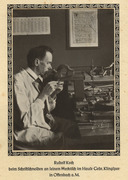
Rudolf Koch's Workbench
Several photographs of Rudolf Koch at his punchcutting workbench (and of his bench alone) have been published. All of the ones that I know of are still in copyright, so I can't reprint them here in high-resolution scans (which is what you need to see the details of the tools on his bench). They're not that difficult to obtain, however.
1. At his Klingspor Punchcutter's Bench:
The most often reproduced of these photographs is the one which appeared at least as early as the Klingspor specimen booklet for Jessen-Schrift soon after Koch's death in 1934. (The reference icon above left is from a scan of my copy of this specimen.) It shows the punchcutter's elevated bench pin and also Koch's counterpunching fixture.
A very slightly cropped version of this photograph appeared in a Klingspor specimen booklet, in English (and I believe for the English, not American, market), for Koch's face Marathon. Undated, but 1930s. As yet, I've only seen this in a bookseller's online listing.
The next appearance of this photograph (that I am aware of) was in Oskar Beyer's 1953 biography Rudolf Koch: Ein Schöpferisches Leben {Beyer 1953}. Of all of the published reproductions, this one is the best. It shows no signs of having been cropped, and it has the greatest tonal range (useful for making out details of the tools).
Flickr user "typesticker" has posted a photograph of this page/illustration in Beyer: https://www.flickr.com/photos/34564322@N03/5344350275/
In 1970, a cropped version of it appeared in the chapter "Type: Cutting and Casting" in Warren Chappell's A Short History of the Printed Word {Chappell 1970}, p. 41. Because Chappell studied under Koch, his comments in the photograph caption identifying the tools on the bench are particularly valuable:
"Rudolf Koch filing a punch against the pin. In the foreground are heavier files, gravers, and a stake [fixture, really] for counter-punching. At the rear can be seen a vise, a torch for hardening the finished punches, and stones on which the surfaces are planed."
This photograph is probably best known today because it appears on the dustjacket of Gerald Cinamon's biography Rudolf Koch: Letterer, Type Designer, Teacher (and again on p. 145 of that work) {Cinamon 2000}. Cinamon attributes the photograph to Ed. Meyer and cites the Klingspor Museum as his source. However, both versions of this photograph in Cinamon are cropped, and the version on the cover has been retouched to eliminate part of the background.
It is also online on the website of the city of Offenbach, at: https://www.offenbach.de/kultur-und-tourismus/stadtgeschichte/geschichte-offenbach/1933-1945/rudolf-koch-stirbt.php. The version on the offenbach.de website is only slightly cropped and is actually clearer than the halftones in Cinamon.
Finally, it is online in a heavily cropped version which cuts out most of the tools at http://www.rudolfkoch.de/
2. At his Werkstatt Bench (circa 1928):
Cinamon also reproduces a photograph from the Klingspor Museum, which he dates "circa 1928," of Koch at a workbench in his Werkstatt (p. 122). This is an interesting photograph because while this appears to be a punchcutting bench at first glance (e.g., the vise is very similar to the one in the photo above), it does not have a punchcutter's bench pin but instead an engraver's sand or shot bag. See the discussion of this photo in the context of the cutting of Neuland in the Notebook of literature on Patrix Cutting in Soft Metal by Hand for more information.
3. His Klingspor punchcutting bench after his death in 1934:
Cinamon reproduces (p. 173) a photograph which appeared in an article by Ernst Engel, "Kochs Arbeitsraum bei Gebr. Klingspor" in Graphische Nachrichten (June 1934): 256. It shows Rudolf Koch's workroom, and punchcutting bench, at Klingspor shortly after his death."
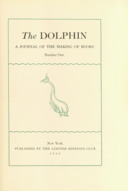
Paul Koch & Fritz Kredel (1933)
Koch, Paul. "The Making of Printing Types." Illus. Fritz Kredel. Trans. Otto W. Fuhrmann. In The Dolphin: A Journal of the Making of Books . No. 1. NY: The Limited Editions Club, 1933. Pages 24-57. Macy's department store renewed the copyright on The Dolphin, so this article is still in copyright and I can't reprint it. However, it is available online at Carnegie-Mellon University's Posner Library: http://posner.library.cmu.edu/Posner/
Koch covers punchcutting, matrix striking and justification, and hand casting. The illustrations by Kredel are particularly clear.
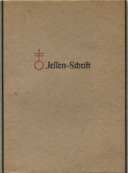
Jessen Schrift [Specimen Booklet] (ca. 1934)
Anon. & Rudolf Koch. Jessen-Schrift [Specimen booklet] Offenbach am. Main, Germany: Gebr. Klingspor, ca. 1934.
This specimen booklet is notable for several reasons beyond its showings of Jessen Schrift. It contains:
I was confused, when looking at the reproductions of Kredel's illustrations for various versions of Rudolf Koch's "Vom Stempelschneider" article, as to which illustrations appeared with which version. The two illustrations which appear in the Jessen-Schrift specimen are these:
(Note that the counterpunching apparatus shown in Kredel's first woodcut, which is the same one shown on Rudolf Koch's Klingspor workbench as discussed in the photographs section above, is difficult to understand if one is familiar only with the style of counterpunching tool used by Edward Philip Prince (as shown in the frontispiece to Avis' biography of Prince). (There isn't enough room in its base to accomodate the full length of the punch.) The solution is shown in Paul Koch's 1933 Dolphin article (p. 36): the punch projects below the fixture, and the entire fixture is held freehand, supported by the punch. All of this will make no sense at all until you acquire the pictures, at which point you'll wonder why I made such a big deal about it.
Lars Schwarz has also put online a photograph of the two-page spread from this specimen booklet which contains these two Kredel woodcuts: https://www.flickr.com/photos/bitrocker/8476536324/
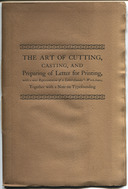
Anthoensen (1939)
Moxon, Joseph and Fred Anthoensen. The Art of Cutting, Casting, and Preparing of Letter for Printing, with a Neat Representation of a Letter-founder's Work-house, Together with a Note on Typefounding by Fred Anthoensen. Portland, Maine: The Southworth-Anthoensen Press, 1939.
This is a reprint of the condensed extract from Moxon published in The Universal Magazine in 1750 with a the addition of a "Note on Typefounding" by Anthoensen. See the entry on Moxon, above.
The icon here links to the presentation of this work in the Notebook of General Literature on Making Printing Matrices and Types.
Victor Hammer at Wells College (1939-1948)
From 1939 to 1948, the Austrian-American artist Victor Hammer was a professor at Wells College in upstate NY. The library at Wells has a number of documents and artifacts from his time there, including a set of large-format black-and-white photographs of Hammer at work punchcutting. These are useful first because they show several well-known steps of the punchcutter (e.g., using the Facing Gauge) but second because they show at least two quite unusual variations. In particular, for magnification he used both a (then) relatively common device, the American Optical Co. "Beebe" (brand) binocular loupe and an entirely unconventional solution: binoculars turned backwards.
See also Middleton's Victor Hammer: Artist and Master of the Printing Art (1965), below .
Permissions note: The thumbnail image above left, of Victor Hammer wearing a pair of Beebe binocular magnifiers and blackening a punch at a flame in preparation for taking a smoke proof is Copyright Wells College, from their collection. It is used here with the kind permission of Richard Keglar, Director of the Wells College Book Arts program.

Victor Hammer (Other Images)
A photograph of Victor Hammer at a punchcutting bench in an unspecified location appears at least twice in the literature. It is shown in Alexander Lawson's Anatomy of a Typeface {Lawson 1990}, in his discussion of Hammer's uncials (p. 46). The identifying icon at left is taken from that source. The same photograph is used (as of 2016, at least) on the Victor Hammer page of the Linotype.com website, at: https://www.linotype.com/428/victor-hammer.html It is a rather dark photograph in all sources that I've seen, and it doesn't show much detail of his equipment, but I think it does show his unusual use of reversed binoculars for magnification (this is actually easier to make out in the low-res but sharper version on Linotype.com as opposed to the higher-res but muddier version in Lawson's book.) I do not yet know the provinance of this photograph or where it first appeared.
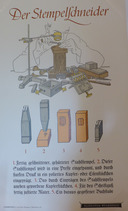
Klingspor Type Foundry (n.d.)
Lehrtafel ["teaching posters"] No. 1, "Der Stempelschneider." One of a series of six posters by the Klingspor Type Foundry (Offenback am Main: Gebr. Klingspor, no date) illustrating various aspects of type-making.
Actually, all of the posters are relevant to punch or patrix based methods for making type:
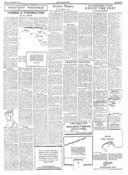
Carter (1945)
Carter, H. [Harry] G. "Making a Printing Type." The Palestine Post. (14 December 1945): 7. This newspaper has been digitized by Prof. Ronald W. Zweig and The Jerusalem Post and is online on the "Historical Jewish Press" website of the National Library of Israel and Tel-Aviv University: http://web.nli.org.il/sites/JPress/English/Pages/Palestine-Post.aspx To view it, click on the "View Newspaper" button from the page linked above. Then select the year (1945) and the issue (December 14). Carter's article is on page 7. It is in copyright, so I cannot reprint it here.
John Lane, in his article "Twentieth-Century Punchcutters" in Matrix 11 identifies two reprints of this article ("omitting some illustrations") "as a four page brochure": once "without date or place of publication" and again by The Typophiles in October 1974.
Carter's article gives a high-level (but of course accurate) overview of hand punchcutting and typefounding. Its occasion was his cutting of a Hebrew type, "the first complete type ever made in Palestine" (in 1945 Carter, then in government service, was Chief Censor in British Mandatory Palestine). It is heartening for the student of punchcutting to read:
"In making [this type] I have learnt something of the lot of a pioneer in a new country, without materials, without tools, without even reference books.
"Making type under these conditions is rediscovering printing. There is always satisfaction in starting from nothing."
The article was accompanied by two illustrations: a photograph of "Cutting Punches" and a showing of the type. The photograph is indecipherable in the poor reproduction online. The showing is better, but still poor.
Fortunately, a flickr user, Philipp Messner, has posted a good quality photograph of this showing (from an unspecified source) and licensed this photograph for noncommercial re-use under the Creative Commona Attribution-NonCommercial 2.0 license. See: https://www.flickr.com/photos/philipp75/15973611926 Here is a local copy of this photograph of the specimen:

Chappell (1953)
Let's Make a B for Bennett. ([no location]: Friends of Paul Bennett, 1953.) N.B., also distributed as Monograph 40 of The Typophiles. This work is accurate and well illustrated, but very short and simplified. It is almost a children's book (which is a compliment, not a criticism).
The icon here links to a presentation of this book at The Internet Archive. Here is a local copy of the PDF (61 Megabytes): chappell-lets-make-a-b-for-bennett-0600rgbjpg.pdf


Bohadti (1954) / Duensing (1968)
Bohadti, Gustav. Die Buchdruckletter: Ein handbuch für das schriftgiesserei- und buchdruckgewerbe. West Berlin, West Germany: Ullstein A. G., 1954.
Duensing, Paul Hayden, trans. & ed. Type Matrices: Being Chapter IV of Die Buchdruckletter, translated, with a biographical note, the original illustrations, and a bibliography. (Kalamazoo, MI: The Private Press and Typefoundry of Paul Hayden Duensing, 1968.)
Bohadti's 1954 book is probably the most comprehensive technical account of matrix making and typefounding from the mid-20th century. It is in German, which is a difficulty for those who cannot read German (I cannot). Fortunately for us, the late Paul Hayden Duensing translated the chapter on matrix making.
Bohadti treats of all three methods of matrix making as equal (punchcutting in steel, patrix cutting in soft metal with subsequent matrix electroforming, and direct matrix engraving) - though if anything the relatives weights of his treatment emphasize patrix cutting. Because of its importance to patrix cutting, I've put the primary entry for it in the Notebook of literature on Patrix Cutting in Soft Metal by Hand -> Bohadti (1954) / Duensing (1968). Both of the icons above link to that presentation.

Rädisch
Several images exist which show either Paul Rädisch at his workbench or his workbench and its tools alone.
Malou Verlomme's Master of Arts in Typeface Design dissertation at Reading University, "Technological Shifts in Type Design and Production" {Verlomme 2005} contains a photograph taken by Verlomme at the former Museum Enschedé in Haarlem, Netherlands, showing Paul Rädish's workbench on display with some tools. The rack for the gravers is particularly interesting. It is also interesting to compare views of this bench with the same bench and tools as shown in use in Carl Dair's film Carl Dair at Enschedé: The Last Days of Metal Type. ( see below). For example, the gas burner used for hardening and tempering originally had a cylindrical shield around it which is not present in the museum display.
Formerly this dissertation was online at: http://academic.typeculture.com/wp-content/uploads/2016/02/tc_article_34.pdf An archived copy may be retrieved, however, from the "Wayback Machine" at The Internet Archive, www.archive.org (The icon above is a small-scale copy of this photograph used here simply for positive identification when you find this source.)
As of 2016, Google Image searching still turns up an image of Rädisch at his workbend for a page within the "typography.guru" site which no longer exists. This image (a small version of which appears below for identification) is actually a still from the Carl Dair film (at 21:47 or so into the film).
A similar (but not identical) photograph appears in an interview with Matthew Carter in Creative Characters [the newsletter of myfonts.com], No. 73 (October 2013). See: https://www.myfonts.com/newsletters/cc/201310.html
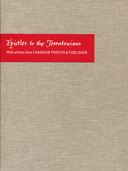
Dair (1956/7, 2015)
Dair, Carl. Epistles to the Torontonians, with Articles from Canadian Printer & Publisher. Toronto: Coach House Press with Sheridan College and New Castle, DE: Oak Knoll Press, 2015. With a DVD containing the film Carl Dair at Enschedé: The Last Days of Metal Type. (Introduction by Rod McDonald and narration by Matthew Carter, together with an interview with Matthew Carter, "Reflections on Enschedé," from 2009.) ISBN: 978-1-55245-335-3 (Coach House Press) and 978-1-58456-339-6 (Oak Knoll Press).
This is an extraordinary book. It is not a shop manual on punchcutting, but instead is an account of the time the Canadian typographer Carl Dair spent in 1956 at the Enschedé type foundry in the Netherlands learning punchcutting from Paul H. Rädisch. It's told primarily through his letters back to Canada, which are reproduced photographically.
The accompanying DVD is a modern edition of film that Dair shot in 1957 of these events plus a 2009 interview with Matthew Carter, who (among his many achievements) also studied punchcutting there. To the student punchcutter, parts of this film are worth going through frame-by-frame.
The book also reprints several articles that Dair wrote for Canadian Printer and Publisher. The one of greatest interest here is "How to Punch-Cut Foundry Types in Steel," which appeared originally in April 1957 (third in the series of articles). This article contains a number of interesting illustrations, including a form of lining gauge I haven't seen before and an illustration of the cutting of the slopes of the punch which differs fundamentally from the method of a "long slope" and "talus" that I learned from Stan Nelson (and he learned, in turn, from Nelly Gable at l'Imprimerie Nationale).
I find this book to be a pleasantly slow read. I can only read the letters one at a time, pausing between them, as if I was reading them as they arrived in the late 1950s.
Do note, though, that there is one error of collation and omission in this book. The fourth page of letters (they are unpaginated) has a letter starting on it dated August 24, 1956. But then later on the 65th page of letters, this same first page of the August 24, 1956 letter appears again, in place of a March or April 1957 letter's first page which should be there.
The film is also online, though stripped of any reference to this book; the technically best presentation is on Vimeo at: https://vimeo.com/165201643
It is very sad, I think, that people will enthusiastically repost material such as this without even a reference to its source. So many of the people who have seen this video online (and it is popular) would really like to have access to the rest of the materials of this book. The world would be a better place for what they might do with what they learned. But they'll never even know it existed; it has been denied to them.
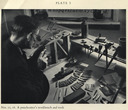
Carter (1963)
The 1963 exhibition "Printing and the Mind of Man," recorded in a book of the same title ([no location]: Messrs F. W. Bridges & Sons Ltd. and The Association of British Manufacturers of Printers' Machienry (Proprietary) Ltd., 1963) contained a photograph of Harry Carter at a punchcutter's workbench.
A short article by Steven Tuohy, "Punchcutting by Hand: a View over the Shoulder of Harry Carter" ( Matrix 11 (Winter 1991): 24-26) reproduces this photograph, identifies some of the tools in it, and provides some historical details of its making. Harry Carter's son Matthew Carter (who also did work at this same bench) assisted with this information.
Matrix 11 also contains Mosley's original publication of the heretofore unpublished plates on typefounding from the 1690s for the Description des Arts et Métiers of the Académie Royale des Sciences and Lane's study of Twentieth-Century Punchcutters.
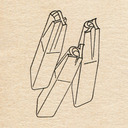
Middleton, Forgotten Art (1965)
Middleton, R. Hunter. An Essay on the Forgotten Art of the Punchcutter. (1965)
This is a small work in which R. Hunter Middleton (primary type designer for the Ludlow Typograph Company) discusses punchcutting. While this is not a detailed explanation of the process, and while Middleton himself was not a punchcutter, this work is historically important because in it he reports the thoughts of Victor Hammer on punchcutting. (See also the entry for Middleton's Victor Hammer: Artist and Master of the Printing Art, below. )
This work presents a puzzle for the bibliographer. The icon here links to a local presentation of it which includes both the published chapbook and several letters relating to the provenance of this particular copy.
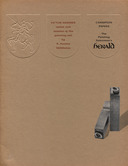
Middleton on Hammer (1965)
Middleton, R. Hunter. Victor Hammer: Artist and Master of the Printing Art. (Chicago: Champion Papers, Inc., 1965). This booklet appeared as No. 14 of The Printing Salesman's Herald, a house organ of Champion Papers, Inc.
This is Middleton's sympathetic study of his friend Hammer's work (Middleton took an early interest in Hammer's punchcutting, and was responsible for organizing the casting of the first size (12 point) of Hammer's first face, American Uncial).
It is particularly interesting for its photographs of Hammer at work, with two good views of his punchcutting workbench. It also shows Hammer using two forms of magnification not elsewhere attested. In the upper photograph on p. 7, he is shown wearing an American Optical Co. "Beebe" brand binocular loupe. (My wife wears these when selling her jewelry at Steampunk shows. They allow her to remain in costume while still using a binocular visor. She attests that they work quite well.) In the lower photograph on the same page, he is using a pair of binoculars turned backwards. I must try this sometime.
See also the entry for Middleton's An Essay on the Forgotten Art of the Punchcutter and Victor Hammer at Wells College, above.
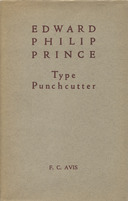
Avis/Prince (1967)
Avis, F. C. Edward Philip Prince: Type Punchcutter. London: [for the author], 1967.
This is of course primarily a biographical work. The frontispiece, however, does show Prince at work using a punch aligning fixture. Each copy also includes, tipped in, an original smoke proof made by Prince.

Chappell (1970)
Chappell, Warren. A Short History of the Printed Word. (NY: Alfred A. Knopf, Inc., 1970.) In particular, Chapter 3: "Type: Cutting and Casting." Illustrated with photographs by Philip Van Doren Stern (taken in 1932), drawings by Rudolf Koch (from 1932), drawings presumably by Chappell, the well-known photograph of Rudolf Koch at his workbench at the Klingspor foundry, photographs of matrices for hand casting by the Stempel foundry, and a comparison of Koch's calligraphy inspiring Koch's face Antiqua and the face as produced by Klingspor (plus other illustrations as the chapter progresses from punchcutting into typefounding and printing).
This is a relatively detailed, illustrated, overview of the process. It is written for the general reader, not the enthusiast, so it is less detailed than, say, Paul Koch's 1933 Dolphin article , but it is more detailed than most lay accounts.
Insofar as this is a record of what Chappell learned in his time studying at the Werkstatt of Rudolf Koch, it really belongs with Koch's work from the early 1930s.
Details: It isn't entirely clear from the captions what the sources of all of Chappell's illustrations are. In particular, his Fig. 3 (files and tools for striking the punch) and Fig. 6 (counter-counter-punch, etc.) are from Rudolf Koch's 1932 Colophon article , and his Fig. 5 (Rudolf Koch at his punchcutting workbench) is the same photograph which first appeared in the Klingspor Jessen-Schrift Specimen Booklet.

Nelson (1984)
Nelson, Stan. "Any Fool can Cut a Punch." Matrix. No. 4 (1984).
This article describes his cutting of his first typeface, Robin (derived from the Carolingian miniscule).
Copies of Matrix 4 now go for nearly $1,500, so I have not yet seen the original with illustrations. Thanks to Stan, however, I have been able to read its text.
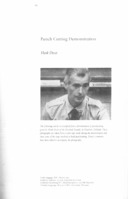
Drost (1985)
Drost, Henk. "Punchcutting Demonstration." Visible Language. Vol. XIX, No. 1 (Winter 1985): 98-106.
Still frames from a videotape of Drost demonstrating punchcutting at Enschedé.
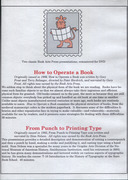
Nelson (1985)
Nelson, Raymond Stanley. From Punch to Printing Type: The Art and Craft of Hand Punchcutting and Typecasting . (Videotape, now DVD) NY: Columbia University School of Library Service, 1985.
This is a complete demonstration of cutting a punch, striking and justifying a matrix, casting type from it, and dressing the type.
This film formerly was available from the late Carl Schlesinger. It is still available from the Book Arts Press of the Rare Books Schoold of the University of Virginia (now on DVD). (The icon here shows the cover of the DVD presentation, where it is combined with another film, How to Operate a Book.)
See also Stan Nelson's punchcutting demonstration in {Nelson 2009} [ Out of Sorts (film), Part 1: Punchcutting at the Atelier Press and Letterfoundry] .

Nelson. Anglo-Saxon Sorts (1986)
Nelson, Stan. ["On Type" feature:] "Cutting Anglo-Saxon Sorts." Fine Print Vol. 12, No. 4 (October 1986): 228-229.
This article does contain technical information, but it is primarily an overview of the punchcutting process and the issues in Anglo-Saxon characters intended for a general reader. Students of punchcutting should note that the illustration accompanying it (drawn by Stan) shows gravers with a secondary or relief shape of an earlier form than that which he now uses. (It shows the relief on the graver cut away in a circular shape. Stan now uses a simple straight relief cutaway.)

Nelson. A New Music Type (1888)
Nelson, Stan. "Cutting a New Music Type." Matrix. 8 (Winter 1988): [pages?]
I haven't seen this yet.
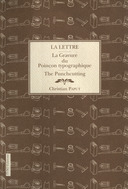
Paput. La Lettre (1990/1998)
Paput, Christian. La Lettre: La Gravure du Poinçon typographique / The Punchcutting. Tallard [?], France: TVSO Éditions, 1998. Engblish translation by Christiane Prat in consultation with James Mosley. Photographs by Sylvie Durand and Christian Paput. A drawing by Jean Clavel. ISBN: 2-9505015-4-0.
This 1998 edition is a bilingual (English, French) version of an earlier French-only edition of 1990.
This is a detailed technical account. Along with Stan Nelson's From Punch to Printing Type {Nelson 1985}, q.v. , it is perhaps the best 20th century source. It also shows several tools not described in other published works, such as the distinctive gauge ("calibre" in French) which appears without comment in several online photographs of punchcutters' workbenches at the Imprimerie Nationale.
This book is in copyright and cannot be reprinted here. It can be difficult to find, but is worth looking for.

Wilkes. Das Schriftgießen. (1990)
Wilkes, Walter. Das Schriftgießen: Von Stempelschnitt, Matrizenfertigung und Letterguss: eine Dokumentation von Walter Wilkes . (Darmstadt, Germany: Technische Hochschule Darmstadt, 1990.) also (Stuttgart:, Germany Hauswedell, 1990) ISBN: 3-7762-0311-0 (same for both Darmstadt and Stuttgart editions). ISBN-13: 978377620311. In German, but well worth having for its illustrations and bibliography, even if you cannot read it.
Wilkes' extraordinarily comprehensive book contains surprisingly few illustrations of punchcutting or its tools. It does contain a photograph of August Rosenberg at work cutting a patrix in soft metal (p. 42). For more on this, see the entry on Wilkes in Patrix Cutting in Soft Metal by Hand: A Survey of the Technical Literature.
(The icon here depicts the title page of this book. The front cover itself is plain red; I do not know if it originally had a slipcover.)
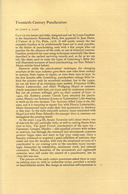
Lane (1991)
Lane, John A. "Twentieth-Century Punchcutters." Matrix, No. 11 (Winter 1991): 7-23.
An invaluable study of a period just barely out of reach.
Matrix 11 also contains Mosley's original publication of the heretofore unpublished plates on typefounding from the 1690s for the Description des Arts et Métiers of the Académie Royale des Sciences and Steven Touhy's analysis of a well-known photograph of Harry Carter at the punchcutting bench.

Nelson & Carr (1991) by May (1992)
May, Alan. Photographs by Elli Hadjiloizi and Nick Howells. "Making 'Real' Type: Virtue Regained." Printing Historical Society Bulletin. No. 32 (Summer 1992): 4-8.
In 1991, Stan Nelson and Dan Carr gave a two-day demonstration of punchcutting at an event called "Type Design, Trdition and Innovation" sponsored by the Department of Typography of the University of Reading (UK) and "organized under the auspices of DIDOT (DIgitalization and Design Of Typefaces." May's article, with Hadjiloizi and Howells' photographs, records this event.
Note that this article appears in the older "Bulletin" of the Printing Historical Society. This publication series has been discontinued (and is distinct from the current PHS newsletter, Printing History News).
May explains the title with a quotation from Stanley Morison's A Tally of Types: "Virtue went out with the hand-cutter when the mechanic came in with his pantograph and the rest of the gear."

Nelson (1992, 2016)
Nelson, Raymond Stanley. 1992 Paris Sketchbook. Revised in 2016 for Stan's class "Understanding the Typographical Punch" at the Wells College Book Arts Summer Institute. Unpublished.
This is Stan's sketchbook from his studies in 1992, with Dan Carr, from Nelly Gable at the Imprimerie Nationale in Paris. It is of great importance, as it contains information not found in published sources. It is presently being revised for publication.
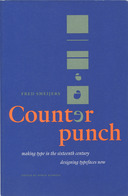

Smeijers (1996, 2011)
Smeijers, Fred. Counterpunch: Making Type in the Sixteenth Century[;] Designing Typefaces Now . Ed. Robin Kinross. (London: Hyphen Press, 1996.)
A "revised and reset" edition, lacking Kinross' name, was published by the same press in 2011.
Both editions are of course still in copyright. Both are out of print. Until recently, they were reasonably priced and not difficult to acquire. A quick online search in mid-2016, however, revealed that prices have gone up to absurd levels: from $256 to $4,026 (for a simple trade paperback)!
This book is primarily an analytic look at what making type by hand entails. But while it isn't a shop manual, it does contain considerable technical detail. It is notable, in particular, for reprinting portions of several of the Plates made for the Académie Royale in the 1690s .

Zapf (ca. 1996)
Zapf, Hermann. August Rosenberger 1893-1980: a tribute to one of the great masters of punchcutting, an art now all but extinct. Rochester, NY: The Melbert B. Cary, Jr. Graphic Arts Collection, Rochester Institute of Technology, ca. 1996.
Printed in an edition of 110 copies. I have not yet seen this source; as I write this, the only available copy lists for $750.
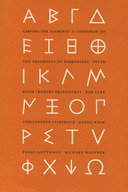
Dan Carr's Articles (1996-2002)
The late Dan Carr, of Golgonooza Letter Foundry & Press, studied at the Imprimerie Nationale in Paris and cut punches for several types by hand.
(The icon here is of the cover of Carving the Elements, in which Carr writes of his experiences in cutting a new face for archaic Greek. This book is more readily available than some other sources of Carr's essays, and in it his remarks on punchcutting are particularly interesting.)
Carr, Dan. "Making a Visible Spirit: Cutting the Regulus Punches by Hand." Matrix: A Review for Printers and Bibliophiles. No. 16 (1996).
This was reprinted in: Berry, John D. and John Randle, eds. Type & Typography: Highlights from Matrix, the review for printers and bibliophiles. West New York, New Jersey: Mark Batty Publisher LLC, 2003. 70-79.
This article is Carr's explanation of why he chose to cut punches by hand in steel. A few tips and remarks on methods aside, it is not a technical description of punchcutting.
Carr, Dan. "Typographic Sculpture: The Survival of Punchcutting at the Imprimerie Nationale." Matrix: A Review for Printers and Bibliophiles. No. 20 (2000).
This is a deeply researched account of the historie of punchcutting at the Imprimerie Nationale from its origins through the early 1990s. It is one of the few sources for biographical information on the punchcutters Christian Paput and Nelly Gable.
Carr, Dan. "Cutting Parmenides." Matrix: A Review for Printers and Bibliophiles. No. 22 (Winter 2002).
Carr, Dan. "Parmenides, Craft, and Being: Designing and Cutting an Archaic Greek Typeface." in Bringhurst, Robert and Peter Rudledge Koch, et. al. Carving the Elements: A Companion to the Fragments of Parmenides. Berkely, CA: Editions Koch, 2004. ISBN: 0974971405 / 9780974971407.
This contains quite a few insights into the practical details of punchcutting - especially the choice and use of particular gravers.
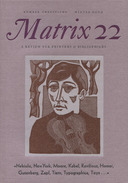
Gable, "gy" (2000, 2002)
Gable, Nelly. Trans. and notes by James Mosley. "gy, ou, la Promenade Fantastique." in Matrix, No. 22 (2002): 88-92, plus one tipped-in sheet of color photographs. Risbury, Herefordshire, UK: Whittington Press, 2002.
Originally published without translation or notes in the magazine Duelle, No. 3 (2000). Paris: Association Duelle pour la poésie, 2000.
This is a poem, really, in prose. First in French, then in English, but originally in steel. With notes and illustrations.
(The icon here depicts the cover of this number of Matrix; it isn't otherwise related to Gable's piece. It isn't clickable - you have to go out and buy the journal on the secondhand market.)

de Chazournes / Parcours Photographique (2004)
de Chazournes, Eric. L'Imprimerie Nationale: Parcours Photographique. This is a photographic study of the entire range of the operations then at the Imprimerie Nationale in Paris (they even had a Rogers Typograph!) It begins with punchcutting and hand casting. This is online on the http://www.garamonpatrimonie.org/ website of the association "graphê" (see below) at http://www.garamonpatrimoine.org/chazournes/patrimoine_in.pdf

Typofonderie Blog (2004)
"Punchcutting at Imprimerie Nationale." 2004-04-19. Online at: https://typofonderie.com/gazette/post/punchcutting-at-imprimerie-nationale/
The photographs in this Blog give a rare view which shows the punchcutting benches more completely. One can see that they are relatively low (or else Christian Paput is very tall!) The chairs do seem very short (as I'm told they are). It is also interesting that while one of the stations has a punchcutter's bench pin, the other has an engraver's bag.

etapes (By 2007)
Rencontre L'Imprimerie Nationale. Paris: étapes.com, 2007? Online in two parts at: https://www.youtube.com/watch?v=UlQycgGwKuk and https://www.youtube.com/watch?v=Yx_tw_3lR5o
This includes video of the punchcutter Nelly Gable, both in an interview and at work. It is entirely in French, but of interest even if you don't understand French (I do not) just for the images of the punches, matrices, and tools of the craft (though they're done so artistically that sometimes you have to go one frame at a time to make anything out).
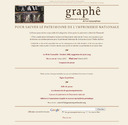
garamonpatrimonie.org (ca. 2007)
The site http://www.garamonpatrimonie.org/ of the association "graphê" has information on, inter alia, punchcutting at the Imprimerie Nationale. Last updated 2007.
In particular, the Parcours Photographique of Eric de Chazoumes (see above) is presented there.

Nelson (2009)
Around 2009, the filmmaker Doug Burnette began a film which was to have been entitled Out of Sorts. Its purpose was to have been to document all phases of hand type-making and casting, through interviews with and demonstrations by Stan Nelson. To the best of my knowledge this film remains unfinished. However, several very good segments of it were published on Youtube by the filmmaker.
Stan's demonstration in these video clips differs in some respects from that in his earlier From Punch to Printing Type (Nelson 1985, q.v.) . For example, in the 1985 film he drew the outline of the punch on the blank. In this film, demonstrates how to duplicate an existing type by making what is effectively a smoke proof of the existing type and transferring that image to the punch blank.

Vervliet's "Conspectus" (2010)
Vervliet, Hendrik D. L. French Renaissance Printing Types: A Conspectus. London, London, & New Castle, DE: The Bibliographical Society of London, The Printing Historical Society, & Oak Knoll Press, 2010. ISBNs: 978-094170-18-2 (Bib. Soc.), 978-0900003-14-1 (PHS), & 978-1-58456-271-9 (Oak Knoll).
Vervliet's detailed and comprehensive study of 16th century types made in France includes an important chapter on the evolution of punchcutting as an independent trade. Although not technical in its focus, it provides a good background for understanding how this craft was practiced at that time.
The practical type-maker should note, however, that Vervliet values the work of the punchcutter to the exclusion of all other aspects of type-making (matrix justification, mold justification, and all vertical alignment (lining), horizontal alignment and set determination (collectively, "fitting") done at the mold or machine by the type caster. In reality these are all important parts of making type and are all reflected in the final printed product. See the discussion of Vervliet in the section on "Type Body Size vs. Type Face Size" in Making Matrices for a more detailed look at this.
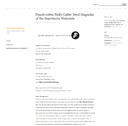
designtraveler Blog (2011)
"Punch-cutter Nelly Gable: Steel Magnolia of the Imprimerie Nationale." 2011-12-13. Online at: http://designtraveler.wordpress.com/2011/12/13/punch-cutter-nelly-gable-steel-magnolia-of-the-imprimerie-royale/

Jourdanet (2011)
The website at http://www.garamond.culture.fr/, which (I believe) commemorates the 450th anniversary of the death of Claude Garamond in 2011, contains a marvelously detailed photograph by O. Jourdanet of a "Punch-cutting station, Atelier du Livre d'Art et de l'Estampe". See: http://www.garamond.culture.fr/en/page/l_imprimerie_nationaleatelier_du_livre_d_art_et_de_l_estampe
This photograph is presented as a Flash object, which on the one hand allows you to zoom in, but on the other hand makes it very difficult to capture images for personal study. It is intended as a romantic image, but it contains some of the clearest views of the tools of the punchcutter available.

Emission Telematin (2012)
"L'atelier du livre d'Art." 2012-01-13. This was a program on French television (Telematin is, so Wikipedia says, something like "The Today Show" in America) on l'Imprimerie Nationale. It has segments showing Nelly Gable at work punchcutting. Online twice (I think they're basically the same clip) at: https://www.youtube.com/watch?v=vUiA_NsZY4c and https://www.youtube.com/watch?v=pqmV7UqYp7g
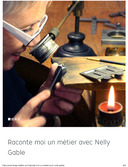
Nelly Gable (IMAP, 2014)
"Raconte moi un métier avec Nelly Gable." Lens, France: Institut des Métiers d'Art et du Patrimonie, 2014. Online at: http://www.imap-institut.com/raconte-moi-un-metier-avec-nelly-gable/
This piece is significant (beyond its interview) because it contains the best photograph of the "gauge" ("calibre") yet published.

The Last Punchcutter (2014/6)
Affanni, Giorgio and Gabriele Chiapparini. The Last Punchcutter [film]. (Bologna, Italy: Griffo the Great Gala of Letters [Associazione Francesco Griffo da Bologna], [filmed Dec. 2014], 2016) http://griffoanniversary.com Online at: https://vimeo.com/169673676
This atmospheric film shows Giuseppe Bracchino, "Former head punchcutter of [the] Nebiolo [type foundry in Turin]" at work in a reconstructed environment. Filmed at the studio of Alberto Tallone in Turin. He is cutting the face "Tallone."
This film raises several interesting questions about method. For example, Bracchino is clearly cutting in steel, but some of his methods (such as the use of an engraver's sandbag) are those of the letter/patrix cutter in soft metal.

Italian Punchcutting (Tallone Collection)
There have been distinct technical traditions in punchcutting - counterpunching vs. gravers, for example. The tools and methods shown in The Last Punchcutter (see above) , which was shot at L'Atelier Tipografico of Alberto Tallone Editore in Italy) and several tools on display at the same location suggest that there has been a different punchcutting tradition in Italy. In particular, the workholding tools differ from those of the punchcutting traditions in Germany/Holland/Belgium and in France.
Arturo Frinzi has posted photographs of several items on display in the Tallone museum on his flickr account at: https://www.flickr.com/photos/bibliotecafrinzi/
Patrick Goossens has posted a photograph of punch holding fixture mounted on a hemispherical base which rests in an engraver's bag on his Facebook pages on 2016-09-15 (but you'll have to search them for it; there's no way that a Facebook URL will survive processing by the system I use for these Notebooks).

Nelson (2016)
Nelson, Raymond Stanley. Understanding the Typographical Punch. Class materials for a class by the same name at the Wells College Book Arts Summer Institute, July 25-29, 2016. Unpublished.
The materials also included a revised version of Stan's 1992 Paris Sketchbook. Both are presently being revised for publication.
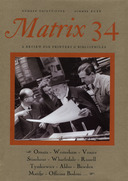
Gill (2016)
Gill, Nick. "Tolerating Englishmen." Matrix. 34 (Summer 2016): 55-60.
Not a technical account, this is Nick Gill's description of having come to cut punches under the tutelage of Stan Nelson.
See also the entry below about his Effra Press blog.
(The image at left shows Henri Matisse, and aside from assisting in identifying Matrix 34 at a glance, has nothing to do with this article.)
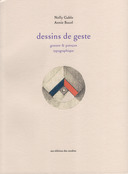
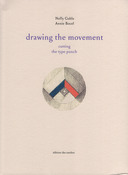
Gable & Bocel, Mosley (2018, 2019)
Gable, Nelly and Annie Bocel. dessins de geste: gravure & poinçon typographique. Paris: Éditions des cendres, 2018. 978-2-86742-284-3. With an introductory piece, "La perle," by Maryline Desbiolles. In French.
Gable, Nelly and Annie Bocel, trans. James Mosley. Drawing the Movement: Cutting the Type Punch. Paris: Éditions des cendres, 2018. 978-2-86742-285-0. With an introductory piece, "The Pearl," by Maryline Desbiolles. In English.
This is the finest and most important book on hand punchcutting ever written. Anyone who desires to cut a punch by hand needs it.

Richard Årlin (Stigbergets Stamp och Press)
The Swedish punchcutter and printer Richard Årlin ( Stigbergets Stamp och Press, http://www.stampochpress.se/) has several videos showing punchcutting, matrix striking & justification, and so forth. His youtube channel is: https://www.youtube.com/channel/UCgDUAPFXSP9hNJPJytQ_61Q
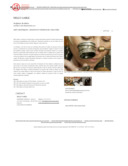
Nelly Gable (INMA)
The Institut national des métiers d'art (Paris) has a very brief web page for Nelly Gable at: http://maitres-art.institut-metiersdart.org/maitre-art/nelly-gable .

Nick Gill (Effra Press & Type Foundry)
The English typefounder Nick Gill is presently (2016) learning punchcutting in the tradition of l'Imprimerie Nationale. He has posted a number of interesting and useful pictures to his blog and via instagram. For the blog, go to his Effra Press & Typefoundry website, http://effrapress.co.uk/typefoundry/, navigate to the blog, and look for images tagged "#punchcutting". He is also on instagram at: https://www.instagram.com/effrapress/
See also his article "Tolerating Englishmen", above.

Patrick Goossens (Letter-Kunde Press)
Patrick Goossens (Letter-Kunde Press, Antwerp) is of course primarily involved with pantographic matrix engraving, but he does have a good photograph online showing Nelly Gable's punchcutting tools as set up for a demonstration in Berlin: https://www.flickr.com/photos/142656814@N05/28735037005/in/dateposted/

James Mosley
James Mosley is perhap the foremost authority on type of our time. His series of articles on his "Typefoundry" blog (but it is really much more than a "blog") at http://typefoundry.blogspot.com is one of the treasures of the Internet.
Several of the articles presented originally on his "Typefoundry" blog have been revised and published in the Journal of the Printing Historical Society, New Series, No. 23 (Autumn, 2015), an issue devoted entirely to his work. This number of the PHS Journal also contains a comprehensive bibliography of Mosley's published works and the first publication of his translation of the section of Jaugeon's work for the Academie on the hand mold.
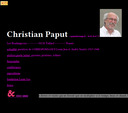
Christian Paput
The punchcutter and artist Christian Paput has his own website at: http://christian.paput.pagesperso-orange.fr/
The typographical punch is a very specialized kind of punch the form of which comes from its use in making matrices for typecasting. There are any number of other kinds of non-typographical punches. The section here is a very incomplete (it could never even approach completeness) and entirely random selection of (potentially) interesting literature on non-typographical punches - just to put the typographical punch in perspective.
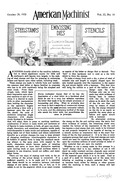
Steelstamps, Embossing Dies, Stencils
Sheldon, Ellsworth. "Steelstamps, Embossing Dies, Stencils." American Machinist Vol. 53, No. 18 (Oct. 29, 1920): 789-794. Digitized by Google from the Univ. of Michigan copy. Google Books ID: lWsfAQAAMAAJ. The icon at left links to an extract of just this article.
1. Lawson's book is one of the best introductory texts on type, metal or otherwise, and he certainly knew his metal type very well. Yet so thoroughly had he been taken in by ATF marketing that he makes several errors in his description of the making of metal type. His discussion of patrix cutting is incorrect (the "molded in wax" part is wrong) and misleading (he emphasizes only its role in pirating existing types). Also, he says that Benton invented a "matrix engraving machine" in 1884. Benton's 1884 vertical pantograph was a patrix and punch cutting machine, which postdated the first direct matrix engraving in America at the Central Type Foundry by two years. Benton himself did not attempt direct matrix engraving until the second version of his vertical pantograph, about fifteen years later near the close of the 19th century.
2. I am indebted to the Bibliography of Karel van der Waarde's web page on hand molds for knowledge of this edition ( http://users.telenet.be/waarde/Handmoulds/references.html). I have not yet seen it.
3. I wouldn't have known of Le Roy's work or of Davis' 1955 book on it without Nash's citations.
4. To add to the confusion, the 1896 DeVinne reprint of the second of Moxon's Mechanick Exercises (the one on printing) was published as two volumes.
5. Matrix 11 is an exceedingly useful volume. It also contains Steven Touhy's analysis of a well-known photograph of Harry Carter at the punchcutting bench and Lane's study of Twentieth-Century Punchcutters.)
{Anthoensen 1939} Moxon, Joseph and Fred Anthoensen. The Art of Cutting, Casting, and Preparing of Letter for Printing, with a Neat Representation of a Letter-founder's Work-house, Together with a Note on Typefounding by Fred Anthoensen. Portland, Maine: The Southworth-Anthoensen Press, 1939.
See entry above for Moxon (1683).
{Ashley 1594} Ashley, Robert. Of the interchangeable course, or variety of things in the whole world [etc.] London: Printed by Charles Yetsweirt Esq. at his house in Fleetestreete neere the Middle Temple gate, 1594.
See entry above for Le Roy (1575).
{Beyer 1953} Beyer, Oskar. Rudolf Koch: Ein Schöpferisches Leben Kassel, West Germany: Bärenreiter, 1953.
{Carter 1969} Carter, Harry. A View of Early Typography Up To About 1600 Oxford: Oxford Univ. Press, 1969. Reprinted London: Hyphen Press, 2002.
These are the Lyell lectures given by Carter in 1968.
{CC 2013} "Matthew Carter [an interview with]." Creative Characters No. 74 (October 2013). [The newsletter of myfonts.com] https://www.myfonts.com/newsletters/cc/201310.html
{Chappell 1970} Chappell, Warren. A Short History of the Printed Word. NY: Alfred A. Knopf, Inc., 1970.
{Cinamon 2000} Cinamon, Gerald. Rudolf Koch: Letterer, Type Designer, Teacher. New Castle, DE and London: Oak Knoll Press and The British Library, 2000.
{Davis 1955} Davis, Herbert. Loys Le Roy on the Art of Printing Oxford: Bibliography Room of the New Bodleian Library, 1955.
See entry above for Le Roy (1575).
{Fassadoni 1769} Griselini, Francesco (original editor) and Marco Fassadoni (editor of this volume). Dizionario delle Arti de' Mestieri. Vol. 6 ("E-F") Venice, Republic of Venice: Modesto Fenzo, 1769.
{Fleischman 1768} For Beschryving der Letter-Gietery Eerste Afdeeling. See {Ploos van Amstel 1768}
{Fournier 1764 I} Fournier [le jeune], Pierre Simon [aka Simon Pierre]. Manuel Typographique. Tome I. Paris: Imprimé par l'Auteur, M.DCC.LXIV.
{Fournier 1764 II} Fournier [le jeune], Pierre Simon [aka Simon Pierre]. Manuel Typographique. Tome II. Paris: Imprimé par l'Auteur, M.DCC.LXIV.
Volume I is the technical treatise. Volume II is a specimen book. See the entry on Fournier in the Notebook of General Literature on Making Printing Matrices and Types for a discussion of the bibliography of and sources for this work.
{Fournier 1930} Fournier [le jeune], Pierre Simon, trans. & ed. Harry Carter. Fournier on Typefounding: The Text of the Manuel Typographique (1964-1768) translated into English by Harry Carter. London: The Soncino Press, 1930.
This is the only translation into English. Although its title says only "the text of," it includes Fournier's illustrations as well.
See the entry on Fournier in the Notebook of General Literature on Making Printing Matrices and Types for a discussion of the bibliography of and sources for this work.
{Fournier 1973} Fournier [le jeune], Pierre Simon, trans. & ed. Harry Carter. Fournier on Typefounding: The Text of the Manuel Typographique (1964-1768) translated into English by Harry Carter. NY: Burt Franklin, 1973.
This is a facsimile reprint of {Fournier 1930}, with a new Introduction by Carter.
{Fournier 1995} Fournier, Pierre-Simon and James Mosley, Ed. The Manual Typographique of Pierre-Simon [sic] Fournier le jeune: Together with Fournier on Typefounding, an English Translation of the Text by Harry Carter. Three volumes. Darmstadt, Germany: Technische Hochschule Darmstadt, 1995.
The first two volumes are a facimile reprint of the 1764 and 1766 originals. The third volume is a reprint of Carter's 1930 translation, with notes by Mosley. All three volumes contain additional information by Mosley.
{Gable & Bocel 2018} Gable, Nelly and Annie Bocel. dessins de geste: gravure & poinçon typographique. Paris: Éditions des cendres, 2018. 978-2-86742-284-3. With an introductory piece, "La perle," by Maryline Desbiolles. In French.
{Gable & Bocel, Mosley 2019} Gable, Nelly and Annie Bocel, trans. James Mosley. Drawing the Movement: Cutting the Type Punch. Paris: Éditions des cendres, 2018. 978-2-86742-285-0. With an introductory piece, "The Pearl," by Maryline Desbiolles. In English.
{Hallens [Halle] 1762} Hallens [Halle], Johann Samuel, Werkstäte der Heutigen Kunste, oder die Neue Kunsthistorie. Volume 2. (Brandenburg an der Havel, Margraviate of Brandenburg and Leipzig, Electorate of Saxony: Johann Wendelin Halle and Johann Samuel Halle, 1762.)
{Jammes 1973} Jammes, André. "Innovation dans l'art de la lettre: Le Grandjean et la naissance de la typographie moderne." [which is a chapter in the book] L'Art du livre à l'Imprimerie Nationale Paris: l'Imprimerie Nationale, 1973.
In citing this article, Mosley omits the first section of this chapter title (which may legitimately be taken to be a subject heading).
This 1973 volume should not be confused with a 1951 volume of the same name.
{ Kurtze... 1740} Anon. [possibly Johann Michael Funcke]. Kurtze, doch nützliche Anleitung von Form- und Stahl-Schneiden. [Short, but Useful Guide to Wood and Steel (punch) Cutting.] [City of] Erfurt, [Electorate of Mainz, Holy Roman Empire]: Johann Michael Funcke, 1740.
This work has been digitized at least three times. See entry above for Kurtze (1740). for local copies.
{ Kurtze... 1998} Boghardt, Martin, Frans A. Janssen and Walter Wilkes, eds. Intro. by James Mosley. Kurtze Anleitung von Form- und Stahlscheiden. Darmstadt, Germany: [no publisher identified], 1998.
{Lawson 1990} Lawson, Alexander. Anatomy of a Typeface. Boston: David R. Godine, 1990.
{Le Roy 1575} Le Roy, Loys [Louis Le Roy; Ludovicus Regius]. De la vicissitude ou variete des choses en l'univers, [etc.] Paris: Pierre l'Huilier, 1575.
See entry above for Le Roy (1575).
{Mosley 1991} Mosley, James. "Illustrations of Typefounding engraved for the Description des Arts et Métiers of the Académie Royale des Sciences, Paris, 1695 to c. 1700." Matrix No. 11 (Winter 1991): 60 - 80.
{Moxon 1683} Moxon, Jospeh. Mechanick Exercises: Or, the Doctrine of Handy-Works. Applied to the Art of Printing. London: Joseph Moxon, 1683.
See entry above for Moxon. Mechanick Exercises (1683) .
{Moxon 1896} Moxon, Joseph. Moxon's Mechanick Exercises, or the Doctrine of Handy-Works Applied to the Art of Printing. 2 vols. NY: The Typothetæ of the City of New York.
This is a re-setting (not a photographic facsimile) of {Moxon 1683}.
See entry above for Moxon. Mechanick Exercises (1683) .
{Moxon 1958/1962} Moxon, Joseph, Herbert Davis (ed), and Harry Carter (ed). Mechanick Exercises on the Whole Art of Printing. Oxford, UK: Oxford University Press, 1958, 1962.
This is the basic modern edition of Moxon with extensive notes and appendices by Davis and Carter. Its title, "Mechanick Exercises on the Whole Art of Printing," is Davis and Carter's, not Moxon's, but as a title for a book with such a complex publication history it works well to distinguish this edition.
See entry above for Moxon. Mechanick Exercises (1683) .
{Moxon 1978} Moxon, Joseph, Herbert Davis (ed), and Harry Carter (ed). Mechanick Exercises on the Whole Art of Printing. NY: Dover Publications, Inc., 1978; ISBN: 0-486-23617-X.
This is a reprint of the second edition of Davis & Carter's edition of Moxon, {Moxon 1958/1962}.
{Moxon 1994} Moxon, Joseph. Intro. John S. Kebabian. Mechanick Exercises or the Doctrine of Handy-Works. Mendham, NJ: The Astragal Press, 1994.
{Nash 1940} [Plantin, Christophe] Nash, Ray, ed. Account of Calligraphy and Printing in the Sixteenth Century. Cambridge, MA: Dept. of Printing and Graphic Arts of the Harvard College Library, 1940.
See the entry above for Plantin (1567).
{Nash 1964} [Plantin, Christophe] Nash, Ray, ed., Foreword by Stanley Morison. Calligraphy and Printing in the Sixteenth Century. Antwerp, Belgium: The Plantin-Moretus Museum, 1964.
Note that the title on the dust jacket has "The Plantin Dialogue on" prepended.
See the entry above for Plantin (1567).
{Plantin 1567} [La premiere, et la seconde partie des] Dialogues Francois, pour les ievnes enfans Antwerp: Plantin, 1567.
See the entry above for Plantin (1567).
{Ploos van Amstel 1768} Anon. [Probably Fleischman] Beschryving der Letter-Gietery Eerste Afdeeling. Amsterdam, Netherlands: Wed. K. van Tongerlo and Son and Maarten Magerus, 1768.
See the entry above for Fleischman (1766) for further details and a copy of the Google digitization of the University of Amsterdam copy of this book.
{Universal 1750} Moxon, Joseph [communicated by "A.B."] "The Art of Cutting, Casting, and Preparing of Letter for Printing, with a neat Representation of a Letter-founder's Work-house." The Universal Magazine. Vol. 6, No. 6 (June 1750): 274-278.
See entry above for Moxon (1683).
{Verlomme 2005} Verlomme, Malou. Technological Shifts in Type Design and Production. M.A. Dissertation, Reading University, 2005.
Formerly this dissertation was online at: http://academic.typeculture.com/wp-content/uploads/2016/02/tc_article_34.pdf An archived copy may be retrieved, however, from the "Wayback Machine" at The Internet Archive, www.archive.org
{Vervliet 2010} Vervliet, Hendrik D. L. French Renaissance Printing Types: A Conspectus. London, London, & New Castle, DE: The Bibliographical Society of London, The Printing Historical Society, & Oak Knoll Press, 2010. ISBNs: 978-094170-18-2 (Bib. Soc.), 978-0900003-14-1 (PHS), & 978-1-58456-271-9 (Oak Knoll).
The covers or title pages of works which are in copyright, as reproduced here in small/icon form, are used here within the limits of "Fair Use" under US copyright law to aid in the identification of the works.
By way of explanation: In most of my online Notebooks, when I encounter a resource that I cannot legally reprint I just leave the "icon" which would have linked to it as a blank white box as a placeholder. Here, though, I've included icons/images to identify most sources, even when they can't be clicked on and don't link to anything. I've done this because some of these sources are so difficult to track down that having a tiny image of the cover of what you're looking for can help a great deal (when browsing booksellers' listings, for example, or searching for an archived web page no longer at its original location). This limited use for identification is, I believe, within the limits of the doctrine of "Fair Use" under U.S. copyright law. I'm still not sure if this is a good idea, but I suspect that the blank white placeholder-squares were confusing people. Let me know (dmm@lemur.com) if you think it is a mistake, or (of course) if it is your image I've used and you'd like it removed despite the provisions of "Fair Use."
The 1896 DeVinne reprint of Moxon is in the public domain, as are Google's scans of it. The extract from it reprinted here remains in the public domain.
Diderot's Encyclopédie and the ARTFL project scans of it are in the public domain. The extract from them reprinted here remains in the public domain.
Chappell's Let's Make a B for Bennett was published in the US without copyright notice at a time when such notice was required to secure copyright. It therefore passed into the public domain upon initial publication. This digital reprint remains in the public domain.
The 2013 photograph by Philipp Messner of Harry Carter's 1945 Hebrew type specimen is licensed by Messner for noncommercial re-use under the terms of the Creative Commons Attribution-NonCommercial license. I am using it here under those licensing terms (my use is entirely noncommercial), but please note that these terms differ from those under which other parts of this page are licensed. Please respect Messner's licensing terms.
All portions of this document not noted otherwise are Copyright © 2011, 2016, 2022 by David M. MacMillan.
Circuitous Root is a Registered Trademark of David M. MacMillan.
This work is licensed under the Creative Commons "Attribution - ShareAlike" license, version 4.0 International. See http://creativecommons.org/licenses/by-sa/4.0/ for its terms.
Presented originally by Circuitous Root®